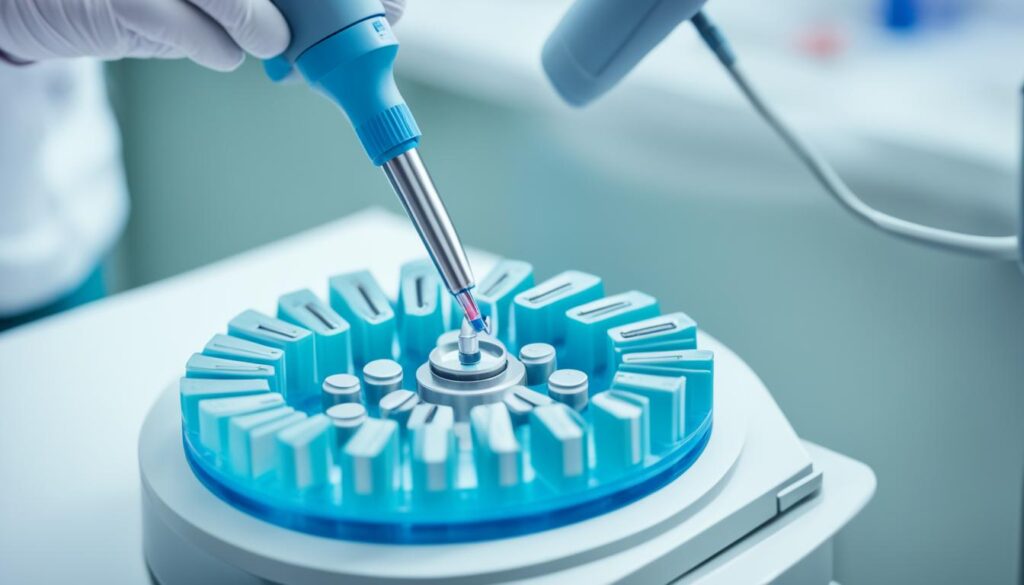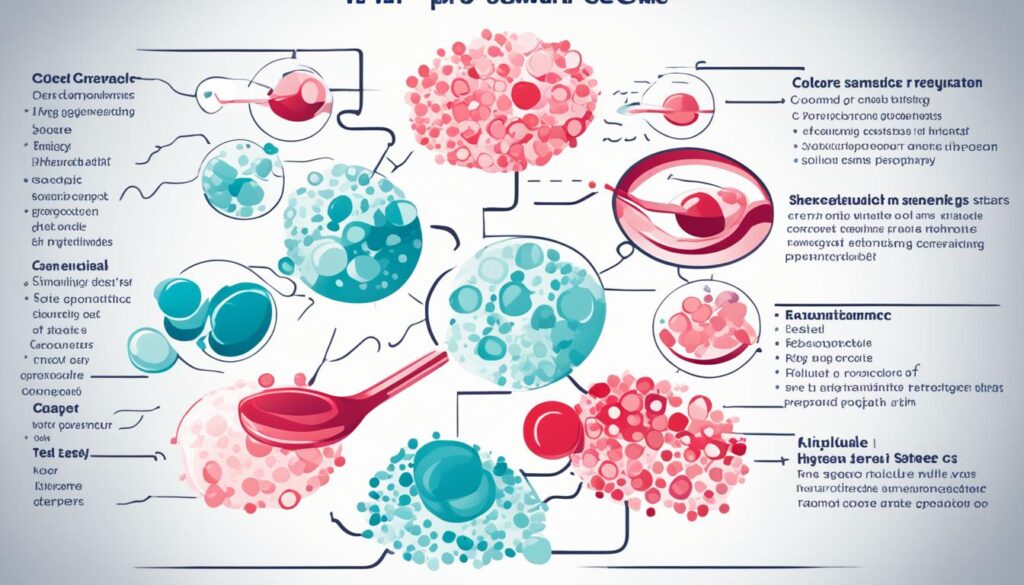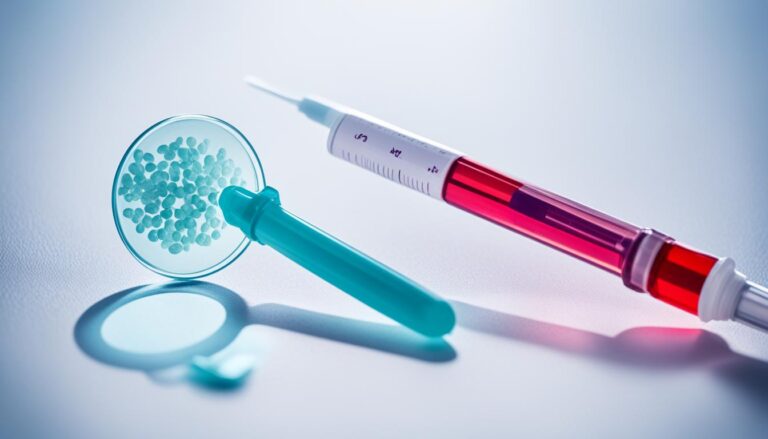Pap smears are key in women’s health exams, focusing on cervical cancer screening. They help find cervix abnormalities that might lead to cancer or early stages of cancer. But, it’s important to know they don’t check for HIV or other infections. These tests are important for different reasons.
HIV testing uses blood, urine, or saliva samples. Finding HIV early is key for starting treatment quickly. This helps manage the virus and keep the immune system strong. With more knowledge about HIV, HPV, and cervical cancer risks, it’s vital to understand Pap smears and HIV tests.
Key Takeaways
- Pap smears are vital for detecting cervical abnormalities but do not test for HIV.
- HIV testing requires specific tests separate from Pap smear procedures.
- Women with HIV should have more frequent Pap smears due to higher cervical cancer risk.
- Everyone aged 13 to 64 should be tested for HIV at least once.
- HPV can be detected alongside Pap smears, which is linked to cervical cancer.
- Early HIV detection is crucial for effective treatment and immune health.
- The Pap smear has significantly reduced cervical cancer death rates since its introduction in 1941.
Understanding Pap Smears
A Pap smear, also known as a Pap test, is key in women’s health. It checks for cervical cancer by looking at cervical cells for abnormal changes. Since its start in the U.S. in 1941, it has greatly lowered cervical cancer deaths.
Women and those assigned female at birth should start cervical screening at 21. They should get a Pap smear every three years after the first test. For those over 30, a Pap and HPV test every five years is best. HPV is common, affecting 79 million Americans, and can cause cervical cancer if not treated.
At 65, women might not need Pap smears anymore if their tests were always normal. Those with weak immune systems, like those with HIV, might need more tests. Some, like those with cervical cancer history or DES exposure, should keep getting tested.
It’s important to talk with healthcare providers about when to get tested. Knowing about Pap Smears and women’s health helps with early detection and prevention.
Learning about these tests helps with better health care. For more on health topics, including schizophrenia and its symptoms, helps people take charge of their health.
The Purpose of a Pap Smear
A Pap smear checks for changes in cervical cells. These changes might show early signs of cervical cancer or precancerous conditions. It’s a key part of cervical cancer prevention.
This test helps find problems early, making it easier to treat them. That’s why it’s so important for cervical cancer prevention.
Women between 21 and 65 should get Pap smears as part of their health care. This is key to fighting cervical cancer.
Women with HIV are especially urged to get screened for cervical cancer. The Department of Health & Human Services has clear guidelines for them. They need regular Pap smears due to their higher health risks.
For those worried about anxiety or ADHD during screenings, finding ways to cope can help. Knowing how mental health affects routine health helps us take better care of ourselves.
How Pap Smears Are Performed
It’s important to know how Pap smears work for good cervical health. A healthcare provider starts by putting a speculum into the vagina during a gynecological exam. This lets them see the cervix clearly, which is key for taking samples.
Then, they use a brush or spatula to take cell samples from the cervix. These samples are sent to the lab for testing. The lab checks if the cells are normal, unclear, or abnormal. This helps decide what steps to take next for cervical health.
Getting regular Pap smears is a big part of staying healthy. The American College of Obstetricians and Gynecologists says women should start at 21. They suggest testing every three years from 21-29 and every five years from 30-65.
Before a Pap smear, there are some things to keep in mind for the best results. Try to schedule it five days after your period ends. Also, avoid sex, tampons, douching, or any vaginal treatments for 48 hours before the test.
| Age Group | Screening Frequency | Additional Notes |
|---|---|---|
| 21-29 years | Every 3 years | N/A |
| 30-65 years | Every 5 years (with HPV test) | Co-testing recommended |
| Over 65 years | Stop if previous results were normal | Must have 3 normal Pap tests in a row |
| History of cervical cancer or HIV | Possible more frequent tests | Consult healthcare provider regularly |
Pap Smears and Cervical Cancer Screening
Pap tests are key in fighting cervical cancer, especially for women’s health. They help find early signs of cervical cancer, allowing doctors to act fast. Women with HIV are six times more likely to get cervical cancer than others. This shows why regular Pap tests and screenings are so important.
The World Health Organization suggests shorter screening times for women with HIV, every three to five years. This is different from the usual five to ten years for others. Studies show that using a second test for HPV-positive women can cut down on treatments by 11-52%. This proves the value of new testing methods in cervical cancer screening.
Using primary HPV DNA testing is a good idea for women with HIV. It’s more effective in lowering cervical cancer cases and deaths than old methods. We need to work on making these better systems available, especially for women with HIV who face more health challenges.
Having access to affordable HPV and triage tests is crucial. So is a good system for getting follow-up care. About 25% of HIV patients don’t get their yearly Pap tests. We need better healthcare efforts to make sure all women, especially those at higher risk, get screened for cervical cancer.

What Pap Smears Can Detect
Pap smears are key in checking cervical health. They look for signs that might lead to cervical cancer. By testing cells from the cervix, doctors can spot changes that could be serious. This helps in catching problems early, which is good for women’s health.
Pap smears also check for other issues, like:
- Precancerous conditions
- Benign abnormalities
- Hormonal imbalances
If a Pap smear finds something abnormal, more tests might be needed. This could include colposcopy or HPV testing. These tests help doctors understand the health of the cervix better. This way, they can act fast if needed.
Regular Pap smears help women take charge of their health. Knowing how these tests work helps them make smart choices. It encourages them to take care of their health early on.
| Screening Recommendation | Age Group | Frequency |
|---|---|---|
| Pap test | 21-29 | Every 3 years |
| HPV test | 30-65 | Every 5 years |
| HPV/Pap co-test | 30-65 | Every 5 years |
| Pap test | 30-65 | Every 3 years |
| Screening considerations | 65+ | Based on medical history |
Understanding what Pap smears can find helps women keep their cervical health in check. Knowing about possible results encourages them to take care of their health early.
HIV Testing: What You Need to Know
HIV testing is key for those at risk of getting sexually transmitted infections. There are different testing procedures, like blood, urine, or saliva tests. The type of test depends on your situation and how quickly you need results.
People aged 15 to 65 should think about getting tested regularly. The CDC and USPSTF suggest at least one test for everyone in this age group. If you’re at higher risk, like gay or bisexual men, you might need tests every 3 to 6 months.
STD clinics are a big part of HIV testing, doing about 20% of tests funded by the government. They find around 30% of new HIV cases. This shows how important testing is in stopping HIV from spreading.
Laboratory tests that check for both antigens and antibodies are the first step in testing for HIV. Getting tested early is crucial because it helps manage the infection better.
Here’s a look at how different tests compare:
| Type of Test | Time to Detect Infection | Usage |
|---|---|---|
| Nucleic Acid Tests (NATs) | 2 to 12 days after exposure | High-risk individuals |
| Antigen-Antibody Tests | 2 to 6 weeks after exposure | Routine screenings |
| Antibody Tests | 3 to 12 weeks after exposure | Follow-up testing |
It’s important to keep up with follow-up appointments to check how treatment is working and watch for complications. Figuring out if you’re eligible for HIV PrEP and PEP is key when getting STI services. Also, tests for infections like tuberculosis and hepatitis are important for people with HIV.
The Link Between HIV and HPV
People living with HIV face a higher risk of health problems, especially with HPV. Women with HIV are six times more likely to get cervical cancer than those without it. This is because HIV weakens the immune system, making it harder to fight off infections like HPV.
About 5% of all cervical cancer cases worldwide are linked to HIV. This is a big concern: HIV patients are more likely to get HPV, and those with HPV are twice as likely to get HIV. So, regular check-ups and prevention are key.
People with HIV are four to five times more likely to get CIN, a precancerous condition. If not treated, this can lead to cervical cancer in 5-10 years, compared to 15-20 years for others. This shows how important it is to stay on top of health checks.
Who gets cervical cancer screenings can vary a lot. Black and Hispanic women with HIV often get diagnosed more often than white women. In some African countries, 40% of women with cervical cancer also have HIV. This highlights the need for better health strategies that tackle both viruses.
Preventing these issues means teaching people about HPV vaccines and cervical cancer tests. The guidelines suggest starting Pap tests at 21 and HPV tests at 30 for women. Vaccines like Gardasil 9 can help lower the risk of these infections and their health problems.
Pap Smears and HIV Detection: The Facts
Pap smears are mainly for checking for cervical cancer. But, they also help find problems in HIV-positive women. These women often get abnormal Pap smear results, which means they’re at higher risk for cervical cancer and HPV-related issues.
Abnormal Pap smears in HIV-infected people show the need for health prevention. Many HIV-positive women don’t get screened enough. For example, only 14.7% of newly diagnosed HIV patients had a Pap smear in the past year. Getting a Pap smear more likely if you have a high income or take antiretroviral therapy.
HPV and HIV work together in a complex way. HPV can stay hidden and come back, especially in HIV-positive women. This makes it vital to have good screening methods. Using Pap smears and other tests can help find serious cervical problems.

Knowing how Pap smears and HIV testing are linked is key for women’s health. Regular screenings are crucial in preventing health issues. Testing early and following up can greatly help those with HIV and cervical cancer risks.
| Study Location | Findings |
|---|---|
| India | High prevalence of colposcopic-histopathologically confirmed cervical intraepithelial neoplasia among HIV-infected women. |
| Lusaka, Zambia | Reported prevalence of 1017-1022 cases of squamous intraepithelial lesions in HIV-infected women. |
| South Africa | Significant rates of abnormal Pap smears found among young women co-infected with HIV. |
| Thailand | High prevalence of cervical cytology abnormalities among HIV-infected women. |
Who Should Get Tested for HIV?
HIV testing is key to preventive health. Everyone aged 13 to 64 should get tested for HIV at least once. This is crucial for HIV testing recommendations.
Some groups face a higher risk of getting HIV. These include people with many sexual partners or those who don’t use protection. They need to be extra careful and get tested often.
People who have had STIs should test more often. Knowing your risk can help you make better health choices. Regular HIV testing recommendations help catch the virus early, stop its spread, and start treatment fast.
Doctors suggest extra steps for certain groups. This includes men who have sex with men, people who use injectable drugs, and those with HIV-positive partners. Learning about these at-risk populations helps improve testing and keeps communities healthier.
| Risk Factor | Recommended Testing Frequency |
|---|---|
| General Population (Ages 13-64) | At least once |
| Individuals with Multiple Partners | Every 6-12 months |
| Men Who Have Sex with Men | Every 3-6 months |
| People Using Injectable Drugs | At least once a year |
| Individuals with STI History | Every 6-12 months |
| Pregnant Women | At first visit and again in third trimester |
Knowing how important HIV testing is helps everyone stay healthy. Regular testing helps manage personal health and fights HIV spread in the community.
Frequency of Pap Smears for Women with HIV
Women with HIV are at a higher risk of cervical health problems. Studies show that HIV-positive women in clinics are up to 11 times more likely to have cervical dysplasia than others. To keep their cervical health in check, HIV-positive women should get Pap smears more often than others.
Experts recommend a yearly Pap smear for women with HIV. This is because 32% to 33% of HIV-positive women in clinics have dysplasia, compared to just 4% to 3% in the general public. Regular screenings help catch problems early, which can lead to better health outcomes.
It’s important to know how HPV affects cervical health. About 67% of HIV-positive women with symptoms have HPV. Many HIV-positive women without symptoms also have HPV. Regular Pap smears help spot early signs of problems that can become serious in HIV-positive patients.
For women with HIV, getting regular Pap smears is key. It’s all about catching problems early and taking action. The risk of HPV and cervical dysplasia means following these guidelines is crucial for better health.
How to Prepare for a Pap Smear
Getting ready for a Pap smear is key to getting accurate results during women’s health exams. Make sure to schedule your appointment when you’re not on your period for clearer results. Avoid using vaginal products like douches or certain medications before your test, as they can mess with the screening.
Talking openly with your healthcare provider is crucial. Share any health worries, big or small, to help them give you the best care. This open talk can lead to a more thorough check-up during your visit.
Learn about the Pap smear process to ease your mind. Knowing what to expect can make your visit less stressful. Most women find out their results in 1 to 3 weeks. If your Pap smear shows unusual cells, it might not mean cervical cancer but could mean you need more tests.
| Age Group | Recommendation |
|---|---|
| 21-29 years | Pap smear every 3 years. |
| 30 years and older | Pap smear and HPV test every 5 years or Pap smear only every 3 years. |
| 65 years and older | Cervical cancer screening may be stopped based on health history and risk factors. |
| With HIV Diagnosis | Screening at diagnosis and 12 months later; follow other recommendations based on age. |
Following these steps can make your gynecological preparation more effective. For more tips on handling tough times, check out strategies for emotional recovery.
Understand Your Pap Smear Results
Interpreting Pap smear results is key to keeping your cervical health in check. These tests can show normal, unclear, or abnormal results. Women aged 21 to 65 should get regular cervical cancer screenings, as advised by the U.S. Preventive Services Task Force.
Women in their 20s should get a Pap smear every three years. Those in their 30s and 40s can choose between a Pap smear every three years, an HPV test every five years, or both every five years. This flexible approach helps tailor screenings to your risk factors and health history.
If your Pap smear shows something abnormal, you’ll need to follow up. This might mean more tests or treatment. It’s important to talk to your healthcare provider about what to do next.
If you’ve had abnormal Pap smears before or have HIV, you might need to get screened more often. Talking to your healthcare provider about your results and what to do next is crucial for your cervical health. Knowing what your results mean can help you take charge of your health.

Next Steps After an Abnormal Pap Smear
Getting an abnormal Pap smear result can be worrying. It’s key to know what to do next for your cervical health.
Women between 21 and 29 should get a Pap test every three years. If the test shows ASC-US or LSIL, you’ll need more tests. HPV testing is a good idea for women 25 and older to find high-risk HPV strains linked to cervical cancer.
Women 30 to 65 should get a Pap and HPV test every five years. If tests show moderate or high-grade changes, you might need LEEP or a cold knife cone biopsy. These procedures remove abnormal tissue.
If you’re under 25 and have ASC-US, you might get another Pap test in a year or an HPV test. But if you have ASC-H, you’ll need a colposcopy to check your cervix closely. If your cells are abnormal, you might need treatment right away.
Follow-up care depends on your test results and health. You can get help from reliable resources and health groups. Being careful with follow-up tests helps you make smart health choices.
Importance of Preventive Healthcare for Women
Preventive healthcare is key for women’s health and wellbeing. Routine tests like Pap smears and mammograms are vital. They help catch health issues early, before they get worse.
The Affordable Care Act (ACA) says most health plans must cover certain preventive services without extra costs. This includes tests for cervical cancer and other important health checks. The Women’s Preventive Services Initiative (WPSI) says women need different tests at different ages and risk levels. For example, Pap tests are needed to find early signs of cervical cancer.
Many women aren’t getting the preventive care they need. Only 59% of women aged 18-64 had a cervical cancer test in the past two years. There are big differences in who gets tested, like income and insurance status. It’s important to fix these gaps to help prevent cervical cancer.
It’s crucial to know about healthcare resources. Teaching women about the full coverage for preventive services could help more women get tested. For instance, 43% of women aged 18-64 don’t know birth control is fully covered. This shows we need to spread the word about preventive healthcare for women.
Continuing Research on Cervical Cancer and HIV
Research on cervical cancer is key in women’s health, especially for those with HIV. Recent studies show that 96.1% of women knew about cervical cancer but only 59.7% got screened. It’s crucial to tackle these gaps to better health outcomes for this group.
Knowing about cervical cancer in HIV clinics boosts screening rates. Women who learned about the disease were more likely to get screened. Getting them to suggest screening during HIV treatment made a big difference, showing the power of good communication in health research.
In Namibia, a big push started in 2018 to fight cervical cancer in seven areas. The goal is to tackle the high rates of the disease, especially among women with HIV. From 2018 to 2020, 14,786 women got screened, showing that 17% of HIV-positive women had early signs of cancer, more than HIV-negative women.
As we keep researching cervical cancer, we’ll get better at screening and treating it. Working together, doctors and researchers aim to make treatments that help women with HIV avoid cervical cancer.
| Statistic | Percentage |
|---|---|
| Women Living with HIV aware of cervical cancer | 96.1% |
| Screening uptake among Women Living with HIV | 59.7% |
| Women informed about cervical cancer in HIV clinics | 1.5 times higher chance of screening |
| Incidence of cervical cancer in Namibia | 24.2 per 100,000 women |
| Screenings conducted in Namibia program | 14,786 |
These ongoing studies and initiatives are crucial for better care for women with HIV. They help us understand how to prevent and treat cervical cancer better. This will lead to better health services and outcomes for these women.
Conclusion
Regular health screenings, like Pap smears and HIV tests, are key for women’s health. Sadly, 79.1% of HIV-positive women didn’t know about cervical cancer risks. Only 20% knew about screening for it. We need better education to help women take control of their health.
Only 13% of women got a Pap smear, often thinking symptoms are needed first. But, high-risk HPV infections and abnormal results can happen without symptoms. This belief is dangerous and wrong.
It’s crucial to tackle these issues to lower cervical cancer risk, especially for HIV-positive women. Knowing how Pap smears and HIV tests are connected helps women make better health choices. By focusing on screenings, women can greatly improve their health and handle HPV and HIV risks better.


